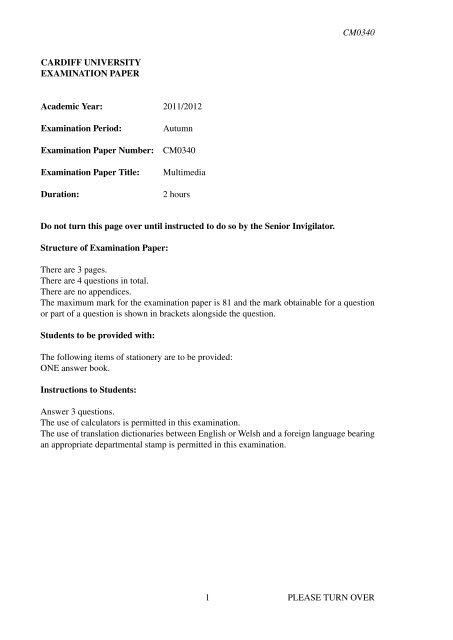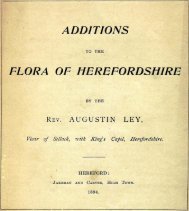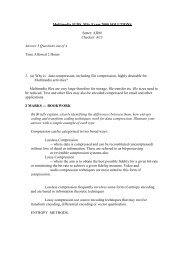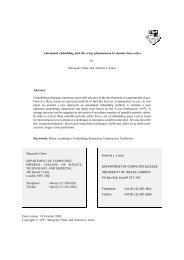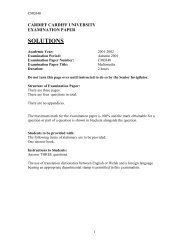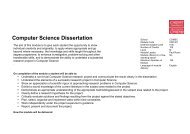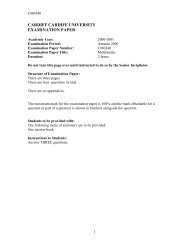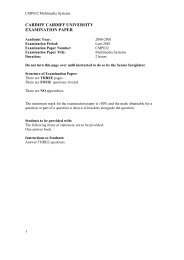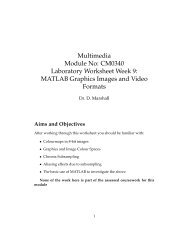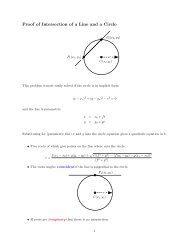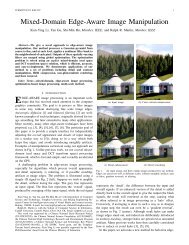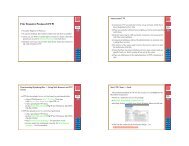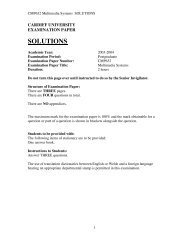Multimedia BSC EXAM Paper 2012 - Cardiff University
Multimedia BSC EXAM Paper 2012 - Cardiff University
Multimedia BSC EXAM Paper 2012 - Cardiff University
- No tags were found...
Create successful ePaper yourself
Turn your PDF publications into a flip-book with our unique Google optimized e-Paper software.
CM0340<br />
CARDIFF UNIVERSITY<br />
<strong>EXAM</strong>INATION PAPER<br />
Academic Year: 2011/<strong>2012</strong><br />
Examination Period:<br />
Examination <strong>Paper</strong> Number:<br />
Examination <strong>Paper</strong> Title:<br />
Duration:<br />
Autumn<br />
CM0340<br />
<strong>Multimedia</strong><br />
2 hours<br />
Do not turn this page over until instructed to do so by the Senior Invigilator.<br />
Structure of Examination <strong>Paper</strong>:<br />
There are 3 pages.<br />
There are 4 questions in total.<br />
There are no appendices.<br />
The maximum mark for the examination paper is 81 and the mark obtainable for a question<br />
or part of a question is shown in brackets alongside the question.<br />
Students to be provided with:<br />
The following items of stationery are to be provided:<br />
ONE answer book.<br />
Instructions to Students:<br />
Answer 3 questions.<br />
The use of calculators is permitted in this examination.<br />
The use of translation dictionaries between English or Welsh and a foreign language bearing<br />
an appropriate departmental stamp is permitted in this examination.<br />
1 PLEASE TURN OVER
CM0340<br />
Q1. (a) What is MIDI [1]<br />
(b) What features of MIDI make it suitable for use in the MPEG-4 audio<br />
compression standard [2]<br />
(c) Briefly outline the MPEG-4 structured audio standard. [6]<br />
(d) What features of MIDI make it suitable for controlling software or hardware<br />
devices [6]<br />
(e) Outline how you could utilise MIDI in the following situations:<br />
• A MIDI controller that has to be able to accommodate a range of values in<br />
excess of 255. [2]<br />
• A MIDI sampler has limited memory but needs to be configured to be play<br />
trumpet sounds at one instant but also violin sounds at other instants. [2]<br />
• A MIDI controlled Avatar where the avatars limbs and facial features are<br />
required to be controlled via MIDI. [2]<br />
• A MIDI controlled toy car where MIDI needs to control the starting and<br />
stopping of the car and also its speed. [3]<br />
• A robot is to be controlled via MIDI. The robot has custom configurable<br />
circuitry that control its movement and sensors. The circuitry has to be initialised<br />
via MIDI. [3]<br />
Q2. (a) How does the human eye sense colour What characteristics of the human visual<br />
system can be exploited for the compression of colour images and video [5]<br />
(b) What is the YIQ colour model How is compression achieved with YIQ in<br />
Analog NTSC Video and Digital MPEG Video [5]<br />
(c) What is a colour look-up table and how is it used to represent colour [5]<br />
Give an advantage and a disadvantage of this representation with respect to true<br />
colour (24-bit) colour. [2]<br />
How do you convert from 24-bit colour to an 8-bit colour look up table representation<br />
[1]<br />
(d) Describe how colour look-up tables can be used to implement simple computer<br />
animations. Illustrate you answer with the following example: In a 7x7 image<br />
you have to animate a 3x3 red square moving from left to right at a rate of 2<br />
pixels per frame. The square is centred vertically within the image and the image<br />
background is black. [8]<br />
Give a limitation of colour look-up table animation [1]<br />
2
CM0340<br />
Q3. (a) GIF and JPEG are two commonly used image representations. Do they usually<br />
use lossless or lossy compression State the major compression algorithm (for<br />
lossless) or the lossy steps of the algorithm (for lossy) for each. [4]<br />
(b) Briefly describe the four basic types of data redundancy that data compression<br />
algorithms can apply to audio, image and video signals. [8]<br />
(c) Encode the following steam of characters using decimal arithmetic coding compression:<br />
MULTI<br />
You may assume that characters occur with probabilities of M = 0.1, U = 0.3,<br />
L = 0.3, T = 0.2 and I = 0.1. [12]<br />
(d) Describe how your solution to (c) would be decoded — you do not need to show<br />
a complete enumerated solution. [3]<br />
Q4. (a) List two psychological phenomena that are exploited in MPEG audio compression.<br />
[2]<br />
Briefly explain their meanings. [2]<br />
(b) How does MPEG audio compression implement methods which use the above<br />
psychological phenomena [8]<br />
(c) What are the fundamental differences between MPEG and Dolby audio compression<br />
algorithms [4]<br />
Give an advantage and a disadvantage of Dolby with respect to MPEG audio<br />
compression. [2]<br />
(d) Given two stereo channels of audio:<br />
Left Channel: 112 102 113 114 115 127 136 144<br />
Right Channel: 112 114 116 104 124 120 122 133<br />
i. Apply Middle/Side (MS) stereo coding to the sequence. [3]<br />
ii. How may this result be employed to achieve compression in MPEG Audio<br />
Illustrate your answer with respect to the above data. [4]<br />
iii. Give two potential problems of this coding method. [2]<br />
3X<br />
END OF <strong>EXAM</strong>INATION


